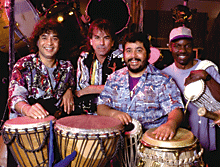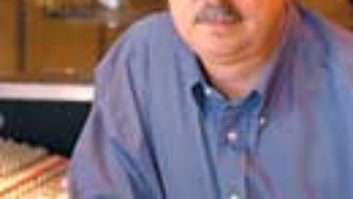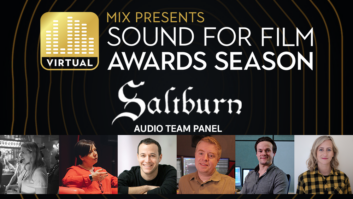
The Global Drum Project, L-R: Zakir Hussain, Mickey Hart, Giovanni Hidalgo and Sikiru Adepoju
It seemed somehow appropriate that when the Grammy Awards introduced a World Music category back in 1991, the first winner was Grateful Dead drummer Mickey Hart for his extraordinary side project Planet Drum, which brought together some of the greatest percussionists in the world for a spellbinding rhythmic voyage. By the time he received that trophy, however, Hart had been beating the planet drum, figuratively, for a long, long time: In the mid-’70s, he and tabla player Zakir Hussain formed one of the first serious world percussion ensembles, the Diga Rhythm Band.
Through his years in the Dead, Hart regularly brought in instruments from all over the world — Chinese gongs, Latin congas, African balafons, Tibetan bowls, Brazilian berimbaus, Eskimo hoop drums, Egyptian tars, etc. — and occasionally invited drummer friends from around the globe to join him and bandmate Bill Kreutzmann during the extended improvised percussion segment that was a fixture of every Dead show. A unique blending of international timbres has marked all of Hart’s solo recordings, from his music for Apocalypse Now (Rhythm Devils Play River Music, 1980), to At the Edge (1990), Mystery Box (1996), Spirit Into Sound (1999), the remarkable album by Kodo called Mondo Head (2001) and the two Planet Drum discs — Planet Drum (1991) and Supralingua (1998).
Hart’s latest group and album — co-billed with Hussain — is called Global Drum Project, released in the fall on the Shout! Factory label, and supported by a very successful national tour of colleges. Joining Hart and Hussain in the band are two other master percussionists with long roots in the Hart/Planet Drum world: Puerto Rican conga phenom Giovanni Hidalgo and Nigerian talking drum master Sikiru Adepoju. On the album and onstage, they weave a hypnotic spell, creating sound tapestries with their utterly unique amalgam of age-old percussion instruments altered with the latest in electronic sound-processing gear. Though the base sounds on any given Global Drum Project jam may be a mixture of, say, talking drum, tabla, conga and Beam (a large mono-chord instrument strung with piano wire), once the different parts are effected in unusual ways the music takes on completely new characteristics, as parts echo or repeat or morph into textural elements far removed from their source sounds. It’s quite a pastiche, at once primal and sophisticated.
The album was recorded at Hart’s Studio X near the tiny town of Occidental in rural Sonoma County, Calif., and it’s there, in an office just above the studio’s open control room, that I interview Hart and Hussain on a beautiful fall afternoon just before the beginning of their tour. I wonder aloud how these two percussion giants, each of whom seems to work constantly (Hussain tours regularly in the U.S. and abroad playing Indian classical music, as well as appearing on other artists’ albums), decide when it’s time to re-convene to make another CD.
“It’s an idea or a vision, or it’s a sonic dream that usually emerges from the crazy mind of Mickey Hart,” Hussain says.

“The great and evil mind of Mickey Hart,” Hart adds with a mischievous smile.
“You get a call,” Hussain continues. “‘I have this thought.’ ‘Oh yeah? Okay.’ And then you arrive here and there’s one little thing that Mickey has discovered. It might just be a bell being hit. Just a bell being hit, but suddenly you are inside the bell; suddenly, you’re seeing every little groove that the carver had made into it and you can see it all vibrate and you can see all the harmonics that bell is putting out, even though it’s one tone. And suddenly it’s not just a point, it’s a line and that leads somewhere. That’s what my experience with Mickey has been — to get inside each instrument and discover that world.
“It was in fact in that [studio] room downstairs that Mickey called me in, and said, ‘Listen to this,’ and it was a metal bell — ding-ding-da-ding — and then it went from that to being something else altogether. It was a mutant X-Men bell,” he says with a laugh. “An X-Bell, and it morphed into a different tonal texture and went somewhere else, and it became rhythmic and a pulse appeared in it and all from that one little stroke. And that was the beginning of this crazy idea.”

Global Drum Project in concert: sound manipulator Jonah Sharp, Hussain and Adepoju
Photo: John Werner
“That was the literal place this album started,” Hart adds, “but the overall vision was, we’ve done acoustic records slightly processed, but now, with the smart [electronics], the thought was to take it out and process it very sophisticated with [Sound-Toys’] Echo Boy and different technologies. Now you can play into the process and perform the processes instead of doing it in post- [production]. So we thought that would be a worthy thing to go after instead of just putting reverb on it and echo and delay and all that, but actually come up with some sort of soundscape that we would go inside of and develop, with all the filigree and arabesques that you can create in that kind of sonic architecture. And do it in real time. So that was the overview.”
The tracks on Global Drum Project began as improvisations in the studio based around different rhythms, loops and/or combinations of instruments. “They go on for hours!” Hart says. “They’re all performances, and what we do is take a piece of the performance, six or eight minutes, and refine that and work with it more. You know who used to do this kind of thing? The band War. They used to play and play and work on these grooves, and then at some point they’d go back and chop a section out and it would become a song. The Grateful Dead used to do it, too. You play and play and play and there’s a sweet spot you come to in the middle or the end or wherever, and you say, ‘Okay, here’s 10 or 15 good minutes.’”
Whereas veteran engineer Tom Flye has handled most of the tracking and mixing on most of Hart’s past projects, on this one he had a more supervisory role during the tracking stage, and the actual recording to Pro Tools was mostly handled by John Paul McLean, Robert Gately and Richard Fisher. Jonah Sharp — who is almost a fifth member of the group in their live shows, performing processes from his own station onstage — also has helped Hart and Hussain understand and navigate through various electronic environments. When it came to mic choices and more traditional recording matters, however, the younger engineers happily deferred to Flye’s expertise; after all, Flye has had a critical role in developing Hart’s sound aesthetic through the years.
“We used a wide variety of mics on this,” Flye says. “There were a lot of [Sennheiser] 421s and 409s, some [Beyerdynamic] M88s; the M88s are good for bottom. The 421s work really well for tuned-typed drums — tablas, congas. But there are a lot of different sources. There are also some Audix D4s on there — they use them live and there are a few percussion tracks on the album that came from live performances.”
“Tom was still very involved,” Hart offers. “He’s got the ear and he has the sensibility; he’s my reference point. My ears are not what they once were. I can hear detail and my recordings still sound fine, but a lot of it has to do with Tom. I’ll say, ‘Tom, am I pushing too much at 8,000?’ Or, ‘Am I laying on this too hard?’ And he gives me the absolute truth. He’ll say, ‘Oh, Mickey, that gated reverb there is too severe.’ I like that about Tom. He also has the kind of telepathy where he won’t even have to say anything — he’ll just look at me and he’ll want to see if I blink. So he’ll suggest something and we’ll change it a little. He’s such a wonderful guy, and he has no ego. He’s only interested in excellence.”
During the sessions, which sprawled over many months, “[Flye] would come by and check every now and then. I have him come in and make sure I haven’t gone off the deep end, [see] if all the processing is in phase; something I might’ve missed. It’s like he makes house calls,” he says with a laugh. “So he’s familiar with the material before he starts mixing, but then he also comes in with a fresh ear and he finishes it off.”

As is the case with every Hart album, there was plenty of experimentation on Global Drum Project. Sitar parts are processed to sound like electric guitars; one track features Hart and Hussain beating on “extraordinarily resonant” hollowed stumps of a redwood tree and a 150-year-old chardonnay vine; the singing of natives from the Papua New Guinea rainforest is part of the ambience on one piece; on a couple of others (and in live performances), Hart added snippets of radio signals into the mix. “It’s all about randomness,” Hart says of his use of the radio as a sound-collage tool. “I turn on the radio and tune it into whatever I want to — in the case of this CD, it was the local AM news station. You don’t know what’s coming up, so it’s random. Obviously, you could tune it into a Chinese station or a political talk show or anything. But I didn’t choose it because it was so meaningful or something. I wasn’t going for the literal translation. Then you put it through a delay, some reverb, or you can tap in delay factors at whatever tempo you want.”
Traditionally, Flye has mixed Hart’s projects on the Neve VR console at Studio X, but this time out he stayed in the box, using a Digidesign ProControl system, which made it a little easier to juggle both the instrumental tracks and the multitude of plug-ins used for processing.
“There’s often 48 channels of instruments,” Flye says. “Sometimes a few of those will be an instrument and its processing. And we had three engines going on [for ambiences]: a TC [Electronic System] 6000, a Quantec QRS and a Quantec XL, so there’s two channels for each one of those, too. We’ve used the QRS, which is an old room simulator, a lot through the years. It’s got a bottom that’s really clear. In fact, it’s one of the few digital reverbs I’ve ever heard that I actually kind of like the sound of, though I do turn down the high end a little bit. But it’s usually part of the big ambience.”
This is the first album of the many Hart and Hussain have made together that carries both of their names, and as I leave the studio, I ask Hart about how their different personalities mesh. “Zakir is the sane one,” Hart replies with a chuckle. “I am the man of chaos, he is the man of order. And we love each other’s eccentricities. He can veer to the world of being too perfect, and I can go to the world of chaos. We meet somewhere in the middle and it comes out great. It’s just like in the Grateful Dead: You can’t explain the alchemy of it, the chemistry of it. I’m just fortunate that I can play with Zakir…and Giovanni and Sikiru. Any day playing with them I feel is paradise on Earth.”







